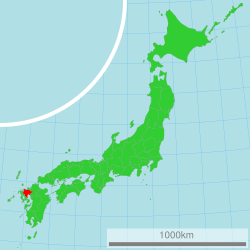Saga Prefecture facts for kids
Quick facts for kids Saga Prefecture |
|||||||||
|
|||||||||
 |
|||||||||
| Capital | Saga | ||||||||
| Region | Kyūshū | ||||||||
| Island | Kyūshū | ||||||||
| Governor | Yoshinori Yamaguchi | ||||||||
| Area (rank) | 2,439.58 km² (42nd) | ||||||||
| - % water | 1.7% | ||||||||
| Population (February 1, 2008) | |||||||||
| - Population | 858,603 (42nd) | ||||||||
| - Density | 352 /km² | ||||||||
| Districts | 6 | ||||||||
| Municipalities | 20 | ||||||||
| ISO 3166-2 | JP-41 | ||||||||
| Website | www.pref.saga.lg.jp/ at-contents/gaikoku/ english.html |
||||||||
| Prefectural Symbols | |||||||||
| - Flower | Camphor blossom (Cinnamomum camphora) | ||||||||
| - Tree | Camphor tree (Cinnamomum camphora) | ||||||||
| - Bird | Black-billed magpie (Pica pica) | ||||||||
| - Fish | |||||||||
 Symbol of Saga Prefecture |
|||||||||
Saga Prefecture (佐賀県 ([Saga-ken] Error: {{nihongo}}: text has italic markup (help))) is a special area in Japan. It is located in the Kyūshū region on the island of Kyūshū. The main city and capital of Saga Prefecture is Saga.
Contents
History of Saga Prefecture
The land that is now Saga Prefecture and Nagasaki Prefecture used to be called Hizen Province. Saga got its current name during the Meiji Restoration. This was a time when Japan changed a lot.
During the Edo period, this area was known as the Saga Domain (佐賀藩 (Saga-han)).
Seven Wise Men of Saga
"The Seven Wise Men of Saga" were important leaders from Saga. They helped Japan become a modern country. They started making changes around the end of the Tokugawa Shogunate. They kept working to modernize Japan during the Meiji Restoration.
- Lord Naomasa Nabeshima was a powerful leader. He brought new ideas and technology from Europe to Japan.
- Sano Tsunetami helped start the Japanese Red Cross. This group helps people in need.
- Shima Yoshitake was an explorer. He traveled and mapped the northern island of Hokkaidō.
- Soejima Taneomi was a member of the Japanese government. He was a Foreign Minister and a Minister of Domestic Affairs. He was also a famous writer and poet.
- Ōki Takatō served as a government minister. He was in charge of Civil Affairs, Education, and Legal Affairs. He was also a member of the Japanese parliament.
- Eto Shimpei was also a Minister of Legal Affairs. He helped create Japan's system of courts and judges. He was also a member of the Japanese parliament.
- Ōkuma Shigenobu became the Prime Minister of Japan. He also founded Waseda University, a well-known school.
Important Dates in Saga's History
- November 19, 1274: The Battle of Bun'ei took place.
- August 15, 1281: The Battle of Kōan happened.
- 1716: Hagakure, a famous book about the Bushido warrior code, was written.
- 1874: The Saga Rebellion occurred during the Meiji period.
- 1975: The Genkai Nuclear Power Plant started working.
- 2011: The Kyūshū Shinkansen (bullet train) line opened.
Geography of Saga Prefecture
Saga is the smallest prefecture on the island of Kyūshū. It has water on two sides. The Genkai Sea and the Tsushima Strait are to the north. The Ariake Sea is to the south. Nagasaki Prefecture is to the west. Fukuoka Prefecture and Kumamoto Prefecture are to the east.
Cities in Saga
Towns in Saga
- Fujitsu District
-
- Tara
- Higashimatsuura District
-
- Genkai
- Kanzaki District
-
- Yoshinogari
- Kishima District
-
- Kōhoku
- Ōmachi
- Shiroishi
- Miyaki District
-
- Kamimine
- Kiyama
- Miyaki
- Nishimatsuura District
National Parks in Saga
About 11% of Saga Prefecture's land is protected as National Parks. These areas help keep nature safe.
Shrines and Temples
Yodohime jinja and Chiriku Hachiman-gū are the most important Shinto shrines (called ichinomiya) in Saga Prefecture.
Related pages
- Provinces of Japan
- Prefectures of Japan
- List of regions of Japan
- List of islands of Japan
- Sagan Tosu
- Kyushu Ceramic Museum
Images for kids
-
A reconstruction of a Yayoi period building at the Yoshinogari site.
-
Ekimae Real Estate Stadium in Tosu.
See also
 In Spanish: Prefectura de Saga para niños
In Spanish: Prefectura de Saga para niños










